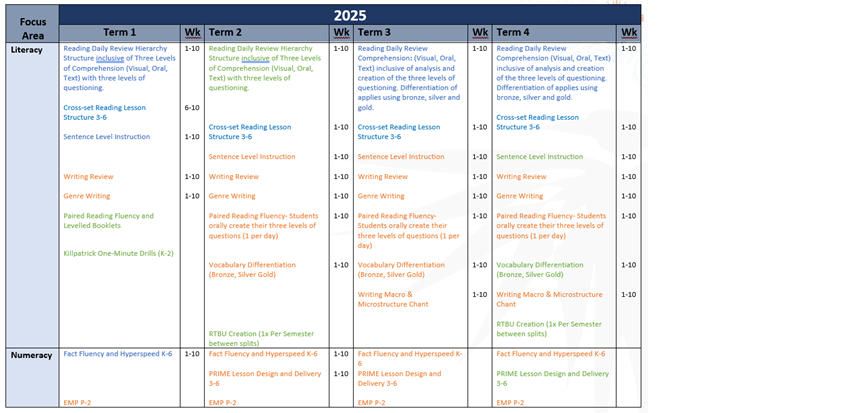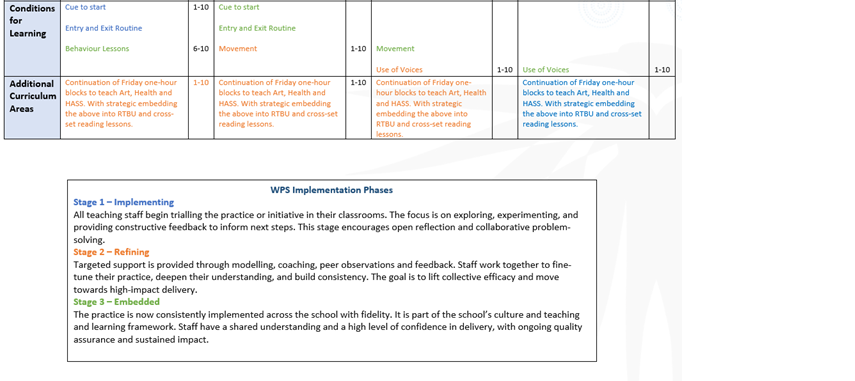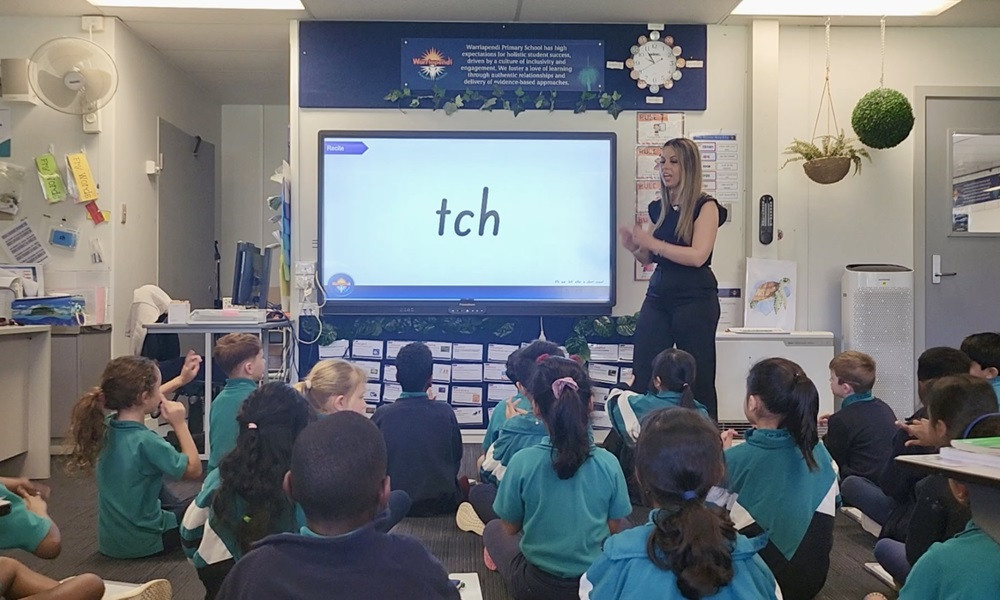At Warriapendi Primary School (WPS) in Perth, Western Australia, the leadership team has been on a journey to build instructional capacity to lift student outcomes. In a 3-part series for Teacher, Principal Matt Pinkard and Associate Principals Deann Jones and Roxanne Righton, share what’s happened so far and the progress they’ve made in literacy instruction. In part one, the team discussed how they’ve cultivated a positive school culture to lay the foundation for building instructional capacity. Part 2 shared their initial implementation steps and how they’re keeping momentum. Here they outline how they’ve refined teaching methods in literacy.
This is the final of 3 articles we’ve written for Teacher. It shares some of the progress we’ve made in literacy instruction. We chose literacy as one of our key areas for improvement – NAPLAN data from 2021-2023 show our school had a significant downward trend across all areas of literacy. Due to significant staffing changes since 2022, pedagogical approaches were inconsistent across the school. To address this, we urgently needed to refine our teaching methods.
Associate Principals (APs) Roxanne Righton and Deann Jones formed a Reading Action Learning Team (RALT) and a Writing Action Learning Team (WALT) comprising of staff from various phases of learning. These teams were tasked with developing daily review structures, school-wide delivery norms and clear expectations for lesson design across all literacy areas.
The Reading Action Learning Team (RALT)
The rollout of the RALT and WALT occurred over 18-months. We began with the RALT as our fine-grained data sets and system-wide data indicated reading was our greatest area of need.
The RALT collaborated with the APs on developing the WPS model for reading reviews and reading lessons derived from evidence-based approaches. Once we agreed on the models, we began creating exemplars for the RALT to trial in their classrooms. This approach helped collate pre and post data to present back to the RALT and refine the model, thus ensuring a smooth rollout process for the rest of the staff.
The team met several more times to finalise the WPS Master Templates containing the bones of our new structures: delivery using Explicit Direct Instruction (EDI), engagement norms and checking for understanding (a process known as TAPPLE); and creation of lesson exemplars for K, P, 1-2, 3-4, and 5-6 to reduce teacher workload and ensure consistency in templates, structures, and content. These were then presented at an all staff meeting using Simon Sinek’s (n.d.) Golden Circle Model.
Teachers were given 3 weeks to trial the refined reading model with their classes, observe RALT members, and familiarise themselves with this new model behind closed doors as they began to upskill and experiment.
After these 3 weeks, the Associate Principal and Impact Coaches reached out to staff to provide individualised support. This included further peer observation, co-teaching and modelling content delivery. As staff gained confidence, they began recording themselves and sharing videos, inviting feedback from colleagues, and using their own time to observe others. The collaborative nature of WPS fostered an environment where staff learned from one another and adopted various strategies, contributing to the streamlined approach our students experience daily.
The Writing Action Learning Team (WALT)
Once our reading model reached the 'refining' stage on our School Acceleration Timeline (which documents what we are focusing on across the year and when), we then began to look at our writing model. As mentioned earlier, system (NAPLAN) and school-level data (BrightPath and Writemark) indicated a downward trend in writing performance. To address this, we invited expressions of interest from staff to join our WALT. Several volunteers from various year levels were selected and allocated DOTT (Duties Other Than Teaching) days to work alongside the APs on refining our genre writing model, sentence-level instruction, and vocabulary instruction.
Explicit vocabulary instruction: This was being used in some classes, but wasn’t mandated or approached consistently school wide. We decided to add it as a requirement on our timetable and created WPS master templates for vocabulary instruction, like we had done for reading and our daily reviews, ensuring it would be taught in a uniform manner. This consistent approach reduces cognitive load for students as they progress through the school, while also increasing the complexity of sentence-level application and vocabulary itself as they advance.
Sentence-level instruction (SLI) and daily writing review (DRW): Both were introduced as new initiatives at our school. Our data indicated that, while students were adept at following a text’s macrostructure, significant gaps existed at the syntactic level. To alleviate teacher workload, we adopted the well-regarded Syntax Project, which aligned closely with our delivery model. After the analysis of a common assessment task, we could pinpoint necessary skills to address within SLI and inform the content of the newly developed DRW. The DRW follows our self-created Hierarchy, inspired by Joan Sedita’s Writing Rope (2023), and includes a fast-paced review of previously taught skills across sentence-level, punctuation, grammar/word knowledge, and text types, including text features and pragmatic functions.
Handwriting: We know that handwriting is essential in reducing cognitive load, as it enables students to process and encode information more effectively by engaging fine motor skills and reinforcing memory pathways, thus freeing up working memory for deeper learning and understanding. Our school selected the Peggy Lego handwriting program for its alignment with cognitive load theory, focusing on structured, explicit instruction that eases mental load by building handwriting skills gradually. Our Early Childhood Education Impact Coach supported this roll out by running after-school professional learning sessions and developing a P-2 and 3-6 handwriting scope and sequence
Rich text-based units: We introduced a strategic literacy initiative to address the unique needs of our large ESL family base. This initiative, based on a rigorous model of explicit literacy instruction, introduces rich text-based units 3 times weekly, integrated into our daily double literacy blocks (one session each morning and afternoon). This structured approach aims to bridge gaps in background knowledge and vocabulary, enabling equitable access to literacy for all students. Drawing on a robust foundation of research, our units are designed to deliver powerful literacy instruction grounded in best practices.
Each unit incorporates essential literacy skills and strategies. There is a strong emphasis on building inferencing skills, vocabulary, and background knowledge, as these are critical to addressing comprehension barriers faced by many of our students. Additionally, each unit has a strong writing component, linked closely with our morning SLI to reinforce reading comprehension, fluency, and word recognition, in alignment with research on the interdependency of reading and writing instruction.
Paired reading fluency: Recognising that background knowledge and fluency are significant barriers to comprehension, we incorporated a structured paired reading fluency routine into our weekly timetable, implemented before our rich text-based units. With an effect size of 0.67, repeated reading is one of the most effective ways to enhance reading fluency (Hattie, 2009). A WPS master template was developed for P-6, embedding research within the framework to continually remind staff of the underlying purpose of this approach (our why).
The routine spans 3 days each week. On day one, students engage in repeated reading within mixed-ability pairs, focusing on literal comprehension questions. Day 2 extends this to include inferential questions, and by day 3, evaluative questions are incorporated. Each week concludes with a 60-second individual speed reading, where students graph their Words Correct Per Minute (WCPM), linked to DIBELS goals and school-wide benchmarks. This weekly progress tracking enables students to visually monitor their fluency improvements. Additionally, we explicitly teach that reading fluency is not about speed alone; it encompasses expression, phrasing, intonation, smoothness, and pace. These aspects are highly scaffolded through model and choral reading in our morning literacy block, ensuring students develop a comprehensive understanding of fluent reading.
High-frequency word hyperspeed: With our understanding of Konza's research (2014), once students have progressed beyond the decoding stage and can instantaneously recognise words by sight (and know their meanings), these words become ‘orthographically mapped’ into the reader's ‘sight vocabulary’. The more words a student can recognise and understand on sight, the greater their fluency rate and accessibility to a broader range of texts.
This insight led to the implementation of a whole-school initiative called Hyperspeed Reading, with targeted benchmarks linked to Fry's 1,000 high-frequency words. Students work through clusters of 100 words sequentially, practising them at a rapid pace until they achieve mastery at ‘hyperspeed’ (reading 100 words in 40 seconds). Teachers monitor incremental progress, mixing the order of words to ensure fluency and mastery before moving students to the next set of 100 words.
This structured approach not only builds fluency and confidence but also fosters a love of learning, as students eagerly work toward mastery and the opportunity to earn achievement badges when they reach each milestone. Slides are sent home for parents to support practice, fostering a collaborative partnership between school and home that strengthens student progress.
Image: High-frequency word achievement badges
Implementing, refining and embedding
Each stage of refinement was documented and presented to staff through an acceleration timeline. The Executive Team led a consultative process aimed to outline what the instructional 'utopia' could look like, and staff were invited to provide feedback on the timeline in their Phase of Learning Team (POLT) deciding what would be achievable and by when, before the final version was published. The colour-coded timeline organised into 3 stages—implementing, refining, and embedded—allowed staff to adopt new practices within a realistic timeframe that they helped to create.
The timeline remains a working document, with POLT leaders regularly updating their teams on progress in each stage.

Click here to view a larger version of this image.

Click here to view a larger version of this image.
How do we know it’s working?
The 2025 NAPLAN results confirm what our internal measures (such as the reading assessment DIBELS) had already shown – that our teaching approach is driving exceptional gains. We ranked among WA’s most improved schools for NAPLAN in 2025. Most significantly, our overall rate of improvement has doubled the gains of Like Schools in reading and writing. Our Aboriginal and Torres Strait Islander students, and students with a Language background other than English, achieved in the top 2 bands for reading, writing and spelling.
Finally, 2025 early years DIBELS data show significant improvement across K-2.


Images: WPS NAPLAN results, compared with WA Public Schools average NAPLAN results, 2023-2025.
This article has provided a brief overview of our work in reading and writing instruction. If you’d like more detail on anything we’ve mentioned – for example, the scope and sequence for the learning areas, the skills and strategies foci for units, or the resources we use – please reach out.
References
Hattie, J. (2009). Visible Learning: A synthesis of over 800 meta‑analyses relating to achievement. Routledge. https://www.routledge.com/Visible-Learning-A-Synthesis-of-Over-800-Meta-Analyses-Relating-to-Achievement/Hattie/p/book/9780415476188
Konza, D. (2014). Teaching Reading: Why the “Fab Five” should be the “Big Six”. Australian Journal of Teacher Education, 39(12). https://doi.org/10.14221/ajte.2014v39n12.10
Sedita, J. (2023). The Writing Rope: A Framework for Explicit Writing Instruction in All Subjects. https://products.brookespublishing.com/The-Writing-Rope-P1344.aspx
Simon Sinek. (n.d.). The Golden Circle. https://simonsinek.com/golden-circle/



